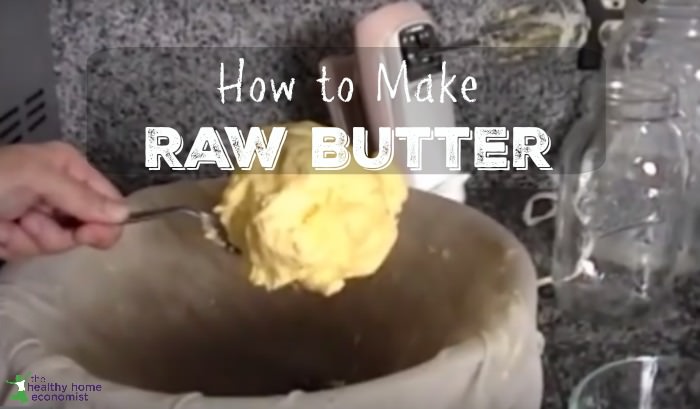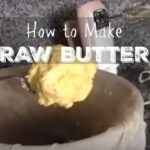Simple and easy recipe with video tutorial on how to make butter from raw or pasteurized cream to enjoy the ancestral health benefits of this nutrient-dense traditional food.

Ah, homemade butter. Has there ever been a more perfect food?
To the Traditional Swiss living in the isolated Loetschental valley early in the last century, raw butter made from unpasteurized cream was a sacred food. No pale supermarket butter, but a golden alpine butter made from the rich, beige raw cream of cows grazing on thick grass.
The children raised on this nutrient-dense, raw butter had strong physiques, and wide faces with plenty of room for their teeth. They also had high resistance to disease. There wasn’t a single case of TB in the Loetschental Valley despite this illness raging elsewhere in Switzerland during the early part of the 1900s. At that time, the Swiss villagers still existed on foods grown or sourced themselves in the valley. Only salt was brought in from the outside.
The young men raised on this nutrient-dense traditional diet with plenty of raw, deep yellow butter were so perfect and pleasing in physique, strength, and character that the Vatican favored them over all others in Europe to serve as the Papal Guard.
The Loetschental Swiss knew that it was this nutrient-dense, raw butter that was responsible for their robust health. The indigenous Swiss would put wicks in bowls of the first spring butter and burn it in their Churches!
We now know that this sacred food contained ample amounts of true Vitamin A, D, and K2. When sufficient amounts of these fat-soluble vitamins are present in the diet, they work synergistically to produce a level of health unknown in modern civilization.
The Importance of Raw Butter in the Diet
When I first became knowledgeable on the subject of Traditional Diets, obtaining plenty of raw, grass-fed butter for my family became a primary goal.
The problem was that raw butter was not available anywhere near where I lived. I couldn’t even find raw cream or unpasteurized milk for that matter!
Determined to have this sacred food for my husband and me (I was pregnant at the time) and for my oldest child who was a young toddler, I sourced quarts of frozen, raw grass-fed cream from elsewhere and shipped in 9 or more quarts a month for my family’s use.
With some of that beautiful beige, grass-fed cream, I would make the most tantalizing, golden butter for my family. I continued this habit for many years.
I am fortunate that now I am able to obtain raw, grass-fed butter locally so I rarely have to make my own raw butter anymore. However, I thought it would be helpful to show you how to make this sacred food for yourself in case some of you are in the same predicament that I was many years ago – desperately wanting raw, grass-fed butter but unable to find any!
How to Source Grassfed Cream
The only thing you really need when making butter is quality pastured cream. Don’t use anything else or your butter will turn out white or at best pale yellow. A light-colored butter indicates a low amount of fat-soluble vitamins.
The easiest route is to buy quarts of raw, grass-fed cream from a local farm. If you don’t have a local grass-based dairy farm nearby, you can request your local health food store to stock a pasteurized cream.
Natural by Nature is a good brand as is this pastured A2 cream.
This brand of Devon cream is excellent too and can be mail-ordered to your door.
Be sure to avoid UHT pasteurized cream by Organic Valley as it is too overly processed.
If you can obtain raw, pastured milk but not cream, you could also take the cream off the top of a gallon or two of the milk using a turkey baster and make butter with that cream.
The key is to get creative!
Don’t take no for an answer if you can’t find quality cream where you live. Figure out where to get it whether it be sucked off the top of a few gallons of grass-fed milk or shipped in from another place. A great way to find farms that will mail order cream to you can be found in the Weston A. Price Foundation Shopping Guide.
Can’t Tolerate Butter?
If due to allergy or availability, you are unable to enjoy the benefits of pastured raw butter on a regular basis, it is very important to be sure you’re getting sufficient Vitamin K2 (called the “X-Factor” by Dr. Price) in the diet via a whole food derived K2 supplement (as MK-7, the fermented form). Another dairy-free option to obtain K2 (as MK-4, the animal form) is Australian emu oil.
Both forms of Vitamin K2 synergize with Vitamin A and D obtained in the diet and/or via high vitamin cod liver oil for maximum absorption and effectiveness. The three together are particularly effective at maintaining the health of the teeth and gums.
Homemade Butter
The recipe below details the instructions demonstrated in the video tutorial. You may use either raw or pasteurized cream, preferably from pastured animals.
Note that once you make the butter, you can easily take it one more step to make homemade ghee, which is shelf-stable. Both ghee and raw butter oil are concentrated forms of all the goodness of butter!

How to Make Butter
Recipe for homemade butter using pasteurized or raw cream. Super easy and when sourced from pastured cows, is one of the healthiest foods on the planet.
Ingredients
- 1 quart cream preferably raw and grassfed
- 1 large glass bowl
- 1 hand mixer
Instructions
-
Pour cream into the bowl and let come to room temperature.
-
Turn on hand mixer on medium speed and mix until the cream turns into butter. You will know this because suddenly, the butter will separate from the buttermilk in the bowl and change color to yellow. This takes about 3 minutes.
-
Add 2 cups ice cold water and remix for a few seconds. Pour butter mixture into a fine mesh cheesecloth, gather up the ends and squeeze bag to strain out the water mixed with buttermilk. Repeat this rinsing process one or two more times as desired to make sure all the buttermilk is removed for the sweetest tasting butter.
-
Scoop the butter into a small container with a lid. Refrigerate.
Recipe Video
Recipe Notes
If you use slightly soured cream in this recipe instead of fresh cream, you will have cultured butter!
Reference
Nutrition and Physical Degeneration, Dr. Weston A. Price








I did exactly what you did with raw cream last Nov. and it was mostly buttermilk, no matter what I did, I couldn’t get more than a few spoons of butter (and it didn’t taste like butter, the whole mixture looked like a few curds and milky liquid). Any idea what happened? I would like to try it again.
Same here. I have failed twice! 🙁 Try to culture with buttermilk and brought everything to 50-60 degrees and still failed.
Down below another commenter said sometimes when the cream is too old it want change into butter. Maybe that was my problem, not sure.
I vaguely remember making butter in grade 1 in the early 70’s. Have to check to see if raw milk or butter can be legally bought here as I think it’s banned.
@Tracy raw butter does not spoil in my experience even after many months. It just gets stronger in flavor so freeze what you will not use in a month or so to preserve the sweetness.
Raw grassfed butter is going to be superior but if that is what you are able to source then that is a good second best option.
What are your opinions about real cultured pastured butter from the store even though it has been pasteurized? And what about using pasteurized cream, even at a low pasteurization?
I live 1 hour drive from the Loetschental valley you talk about 😉
Just to clarify, you’re saying you can leave butter out on the counter for days or weeks and it won’t go bad? It will just change flavor a little as it sours? I hate trying to spread cold butter, but I’m always wary of leaving it out too long!
Use a butterbelle and put small amounts in the butter belle on the counter (refrigerate the rest) at a time and use it up within a few days and you won’t have a problem with the raw butter souring.
I’m guessing this doesn’t last as long as the butter from the store, how long does raw butter typically keep before spoiling?
are there any good uses for the skim milk once you take away the raw cream?
This is great!
I recently had my hubby make butter because we’d run out and he was headed to the store. Since we don’t have a blender or a mixer (blender broke, saving for a Vitamix!) I told him to put cream in a mason jar and shake it. He didn’t believe it but humored me anyway, then 10 minutes of shaking later exclaimed, “Whoa! There’s something solid in here! I just made butter!”
Even though it’s labor intensive, I caught him making more butter the same way the other day. He said it was because he wanted the buttermilk to marinade pork chops in. 🙂
We found a sources for fresh eggs and milk about a 30 minute drive from us, and at our midwife appointment yesterday met a couple who live over an hour away who have a neighbor with cows and pigs that we can buy into for our deep freezer. Yesterday, my hubby mentioned to our landlord that I’ll only eat hamburger “from one cow” (which is premium price at the artisan meats shop in town), so he gave us 4 lbs of hamburger from his own homegrown cow.
Love your blog. Real, whole foods are what I always strive to consume, but following your posts has made it less thought and more action!